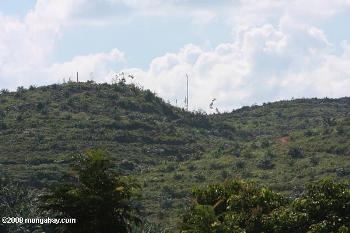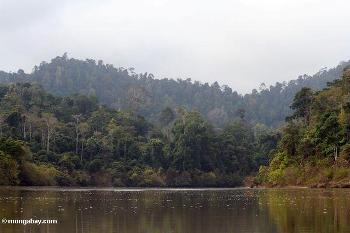Organization recommends expanding REDD to cover all land use change emissions.
The political definition of ‘forest’ used in REDD (Reduce Emissions from Deforestation and forest Degradation) threatens to undermine the program’s objective to conserve ecosystems for their ability to sequester carbon, according to a new analysis by the Alternatives to Slash and Burn (ASB) Partnership for Tropical Forest Margins.
In an analysis of three Indonesian provinces using REDD proposals for carbon accounting, ASB found that REDD may miss up to 80 percent of the actual emissions due to land use change. The carbon accounting problems could be fixed, according to ASB, by expanding REDD’s purpose from reducing emissions linked to deforestation (considering the problematic definition of forests) to reducing emission from all land use changes that either release or capture greenhouse gases, including but not limited to forests.
 Under current definitions of ‘forest’ in REDD this burgeoning oil palm plantation in Malaysian Borneo may be considered forest deserving of carbon payments. Photo by: Rhett A. Butler. |
Environmentalists and policy-makers have long-pointed out a number of problems with REDD. For example, currently the political definition of forest under REDD will allow rainforests to be converted to monoculture plantations, so long as the plantation falls under the REDD definition of forest. In other words, in Southeast Asia oil palm plantations will be considered forests under REDD’s current definition, even though the conversion of rainforest into oil palm plantations releases significant amounts of carbon (oil palm plantation store 50-90 percent less carbon than forests). In addition, conversion from rainforest to oil palm plantations causes other impacts, such as drastic biodiversity loss.
“Countries can clear massive amounts of forest and still claim that deforestation had not occurred,” said Peter A Minang, ASB Global Coordinator, who has extensive experience working with the REDD initiative.
Conservationists also fear that protecting REDD’s definition of forests could push conversion into carbon-important ecosystems that don’t fall under the REDD definition, such as peatlands and sparsely-forested grasslands like Brazil’s vast Cerrado. Peatlands are especially important as they contain more carbon than even an untouched tropical forest.
“On the other hand, large wooded areas that are not part of officially designated ‘forests’ as well as huge tracts of peatlands (which account for 3 to 5 percent of global carbon emissions) would fall outside the definition,” explains Meine van Noordwijk, Chief Science Advisor for the World Agroforestry Centre and a co-author of the ASB analysis.
 Rainforest in Malaysia. Photo by: Rhett A. Butler. |
Agroforestry, where agriculture and forest are mixed in a matrix that has been shown to benefit both farmers and biodiversity, would also be left out of the current REDD proposal. The World Agroforestry Centre has found that half of the world’s agricultural lands have at least 10 percent cover: the percentage goes up in Southeast Asia and Central America, but none of these will receive carbon payments to keep their trees standing.
According to ASB, the best way to incorporate ecosystems that are currently neglected by REDD—peatlands, agroforestry, sparse forest—and keep plantations from benefiting from forest conversion is to expand REDD to the concept of “reducing emissions from all land uses”.
“[This proposal] will be more effective, because it considers carbon in all land uses and could prevent shifting deforestation activities from one area to another,” said Garrity. “It is efficient, because it focuses on areas with high potential climate impact, not on whether they meet an arbitrary definition of forests; and it is fair, because all developing countries could participate, even those that have low forest cover but possess lands with high carbon storage potential.”
An agreement over REDD is expected to be reached this week or next during the Climate Change Conference in Copenhagen.
Related articles
REDD+ could turn deforesters into forest protectors
(12/09/2009) Payments for conservation and sustainable management of forests could turn agents of forest destruction into forest protectors, according to a comprehensive analysis of national policy options to reduce deforestation released in Copenhagen by the Center for International Forestry Research (CIFOR).
Destruction of old-growth forests looms over climate talks

(12/08/2009) Destruction of old-growth or primary forests looms large in discussions in Copenhagen over a scheme to compensate tropical countries for reducing emissions from deforestation and degradation (REDD). Some environmental groups are pressing for conservation of old-growth forests — the most carbon-dense, and biologically-rich state of forests — to be the centerpiece of REDD, while industry and other actors are pushing for “sustainable forest management” or logging using reduced-impact techniques to be the primary focus of REDD.
Cheap REDD isn’t the best conservation strategy for biodiversity
(12/03/2009) The lowest-cost approach to compensating reductions in emissions from deforestation and degradation under a proposed UN program (REDD) isn’t necessarily the best approach for biodiversity conservation, report researchers writing in the journal Science.
In absence of measures to address consumption, REDD may fail to protect forests

(12/02/2009) Rising demand for timber and agricultural products could work against a proposed initiative to reduce emissions from deforestation and degradation (REDD), warns a new report from the Environmental Investigation Agency (EIA). The briefing, Putting the Brakes on Drivers of Forest Destruction: A Shared Responsibility, says that investment in REDD will not be enough to protect forests if the underlying drivers of deforestation — namely consumption — are not addressed. It urges negotiators to re-insert critical text that has been dropped from the working text on REDD ahead of next week’s climate change conferences in Copenhagen.
REDD may not be enough to save Sumatra’s endangered lowland rainforests

(11/24/2009) A prominent REDD project in Aceh Indonesia probably won’t be enough to save Northern Sumatra’s endangered lowland rainforests from logging and conversion to oil plantations and agriculture, report researchers writing in Environmental Research Letters. The study highlights the contradiction between the Ulu Masen conservation project; which involves Flora and Fauna International, Bank of America, and Australia-based Carbon Conservation, a carbon trading company and the continuing road expansion, and establishment of oil palm plantations in the region.
REDD may increase the cost of conservation of non-forest ecosystems
(11/19/2009) Policy-makers designing a climate change mitigation mechanism that will reduce emissions from deforestation and degradation (REDD) aren’t doing enough to ensure that the scheme protects biodiversity outside carbon-dense ecosystems, argues an editorial published in Current Biology by a group of scientists.
Important safeguards to protect rainforests lacking in REDD negotiating text
(11/06/2009) Important safeguards to protect natural forests are still lacking in negotiating text on REDD, a proposed mechanism for mitigating climate change by paying developing countries to keep trees standing, reports an alliance of activist groups.
Without reinstatement of key provision, REDD could subsidize large-scale forest destruction
(11/02/2009) The elimination of a key provision from the negotiating text for the Reducing Emissions from Deforestation and Degradation in developing countries (REDD) mechanism could turn the proposed climate change mitigation scheme into a subsidy for large-scale conversion of natural forests to industrial plantations, warned environmentalists today at the resumption of U.N. climate change negotiations in Barcelona.
Weak forest definition may undermine REDD efforts
(08/20/2009) The weak definition of what constitutes forest under the United Nations Framework Convention on Climate Change (UNFCCC) puts the effectiveness of a proposed mechanism for reducing emissions from deforestation and degradation (REDD) at risk, argue researchers writing in the journal Conservation Letters.